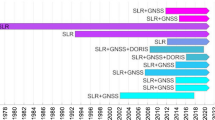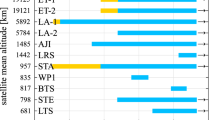Abstract
Of the three satellite geodetic techniques contributing to the International Terrestrial Reference Frame (ITRF), Satellite Laser Ranging (SLR) is generally held to provide the most reliable time series of geocentre coordinates and exclusively defines the ITRF origin. Traditionally, only observations to the two LAser GEOdynamics Satellite (LAGEOS) and Etalon pairs of satellites have been used for the definition of the ITRF origin. Previous simulation studies using evenly sampled LAGEOS-like data have shown that only the Z component of geocentre motion suffers minor collinearity issues, which may explain its lower quality compared to the equatorial components. Using collinearity diagnosis, this study provides insight into the actual capability of SLR to sense geocentre motion using the existing geographically unbalanced ground network and real observations to eight spherical geodetic satellites. We find that, under certain parameterisations, observations to the low Earth orbiters (LEOs) Starlette, Stella, Ajisai and LAser RElativity Satellite are able to improve the observability of the geocentre coordinates in multi-satellite solutions compared to LAGEOS-only solutions. The higher sensitivity of LEOs to geocentre motion and the larger number of observations are primarily responsible for the improved observability. Errors in the modelling of Starlette, Stella and Ajisai orbits may contaminate the geocentre motion estimates, but do not disprove the intrinsic strength of LEO tracking data. The sporadically observed Etalon satellites fail to make a significant beneficial contribution to the observability of the geocentre coordinates derived via the network shift approach and can be safely omitted from SLR data analyses for TRF determination.













Similar content being viewed by others
Notes
References
Altamimi Z, Collilieux X, Métivier L (2011) ITRF2008: an improved solution of the International Terrestrial Reference Frame. J Geod 85(8):457–473. doi:10.1007/s00190-011-0444-4
Angermann D, Müller H (2008) On the strength of SLR observations to realize the scale and origin of the terrestrial reference system. In: Sideris MG (ed) Observing our changing Earth, International Association of Geodesy Symposia, vol 133, Springer, pp 21–29. doi:10.1007/978-3-540-85426-5_3
Argus DF (2012) Uncertainty in the velocity between the mass center and surface of Earth. J Geophys Res 117(B10). doi:10.1029/2012JB009196
Barletta VR, Sørensen LS, Forsberg R (2013) Scatter of mass changes estimates at basin scale for Greenland and Antarctica. The Cryosphere 7(5):1411–1432. doi:10.5194/tc-7-1411-2013
Baur O, Kuhn M, Featherstone WE (2013) Continental mass change from GRACE over 2002–2011 and its impact on sea level. J Geod 87(2):117–125. doi:10.1007/s00190-012-0583-2
Blaha G (1982) Free networks: minimum norm solution as obtained by the inner adjustment constraint method. Bull Géod 56(3):209–219. doi:10.1007/BF02525582
Bouillé F, Cazenave A, Lemoine JM, Crétaux JF (2000) Geocenter motion from the DORIS space system and laser data to the Lageos satellites: comparison with surface loading data. Geophys J Int 143(1):71–82. doi:10.1046/j.1365-246x.2000.00196.x
Chambers DP (2006) Observing seasonal steric sea level variations with GRACE and satellite altimetry. J Geophys Res 111(C3). doi:10.1029/2005JC002914
Chambers DP, Wahr J, Nerem RS (2004) Preliminary observations of global ocean mass variations with GRACE. Geophys Res Lett 31(13). doi:10.1029/2004GL020461
Chen JL, Rodell M, Wilson CR, Famiglietti JS (2005) Low degree spherical harmonic influences on gravity recovery and climate experiment (GRACE) water storage estimates. Geophys Res Lett 32(14). doi:10.1029/2005GL022964
Cheng M, Tapley BD (1999) Seasonal variations in low degree zonal harmonics of the Earth’s gravity field from satellite laser ranging observations. J Geophys Res 104(B2):2667–2681. doi:10.1029/1998JB900036
Cheng M, Shum CK, Tapley BD (1997) Determination of long-term changes in the Earth’s gravity field from satellite laser ranging observations. J Geophys Res 102(B10):22377–22390. doi:10.1029/97JB01740
Cheng M, Ries JC, Tapley BD (2013) Geocenter variations from analysis of SLR data. In: Altamimi Z, Collilieux X (eds) Reference frames for applications in geosciences, International Association of Geodesy Symposia, vol 138, Springer, pp 19–25. doi:10.1007/978-3-642-32998-2_4
Ciufolini I, Paolozzi A, Pavlis EC, Ries JC, Gurzadyan V, Koenig R, Matzner R, Penrose R, Sindoni G (2012) Testing general relativity and gravitational physics using the LARES satellite. Eur Phys J Plus 127(11):133. doi:10.1140/epjp/i2012-12133-8
Collilieux X, Wöppelmann G (2011) Global sea-level rise and its relation to the terrestrial reference frame. J Geod 85(1):9–22. doi:10.1007/s00190-010-0412-4
Collilieux X, Altamimi Z, Ray J, van Dam T, Wu X (2009) Effect of the satellite laser ranging network distribution on geocenter motion estimation. J Geophys Res 114(B4). doi:10.1029/2008JB005727
Cook GE (1965) Satellite drag coefficients. Planet Space Sci 13(10):929–946. doi:10.1016/0032-0633(65)90150-9
Crétaux JF, Soudarin L, Davidson FJM, Gennero MC, Bergé-Nguyen M, Cazenave A (2002) Seasonal and interannual geocenter motion from SLR and DORIS measurements: comparison with surface loading data. J Geophys Res 107(B12):ETG 16-1–ETG 16-9. doi:10.1029/2002JB001820
Desai SD (2002) Observing the pole tide with satellite altimetry. J Geophys Res 107(C11):7-1–7-13. doi:10.1029/2001JC001224
Dong D, Yunck T, Heflin M (2003) Origin of the international terrestrial reference frame. J Geophys Res 108(B4):ETG 8-1–ETG 8-10. doi:10.1029/2002JB002035
Dong D, Qu W, Fang P, Peng D (2014) Non-linearity of geocentre motion and its impact on the origin of the terrestrial reference frame. Geophys J Int 198(2):1071–1080. doi:10.1093/gji/ggu187
Feissel-Vernier M, Bail KL, Berio P, Coulot D, Ramillien G, Valette JJ (2006) Geocentre motion measured with DORIS and SLR, and predicted by geophysical models. J Geod 80(8–11):637–648. doi:10.1007/s00190-006-0079-z
Gobinddass ML, Willis P, Viron O, Sibthorpe A, Zelensky NP, Ries JC, Ferland R, Bar-Sever Y, Diament M (2009a) Systematic biases in DORIS-derived geocenter time series related to solar radiation pressure mis-modeling. J Geod 83(9):849–858. doi:10.1007/s00190-009-0303-8
Gobinddass ML, Willis P, Viron O, Sibthorpe A, Zelensky NP, Ries JC, Ferland R, Bar-Sever Y, Diament M, Lemoine FG (2009) Improving DORIS geocenter time series using an empirical rescaling of solar radiation pressure models. Adv Space Res 44(11):1279–1287. doi:10.1016/j.asr.2009.08.004
Gross RS, Beutler G, Plag HP (2009) Integrated scientific and societal user requirements and functional specifications for the GGOS. In: Plag HP, Pearlman M (eds) Global geodetic observing system. Springer, pp 209–224. doi:10.1007/978-3-642-02687-4_7
Kuang D, Bar-Sever Y, Haines B (2015) Analysis of orbital configurations for geocenter determination with GPS and low-Earth orbiters. J Geod 89(5):471–481. doi:10.1007/s00190-015-0792-6
Lavallée DA, van Dam T, Blewitt G, Clarke PJ (2006) Geocenter motions from GPS: a unified observation model. J Geophys Res 111(B5). doi:10.1029/2005JB003784
Lejba P, Schillak S (2011) Determination of station positions and velocities from laser ranging observations to Ajisai, Starlette and Stella satellites. Adv Space Res 47(4):654–662. doi:10.1016/j.asr.2010.10.013
Lucchesi DM, Ciufolini I, Andrés JI, Pavlis EC, Peron R, Noomen R, Currie DG (2004) LAGEOS II perigee rate and eccentricity vector excitations residuals and the Yarkovsky–Schach effect. Planet Space Sci 52(8):699–710. doi:10.1016/j.pss.2004.01.007
Lyard F, Lefevre F, Letellier T, Francis O (2006) Modelling the global ocean tides: modern insights from FES2004. Ocean Dyn 56(5–6):394–415. doi:10.1007/s10236-006-0086-x
Maier A, Krauss S, Hausleitner W, Baur O (2012) Contribution of satellite laser ranging to combined gravity field models. Adv Space Res 49(3):556–565. doi:10.1016/j.asr.2011.10.026
Meindl M, Beutler G, Thaller D, Dach R, Jäggi A (2013) Geocenter coordinates estimated from GNSS data as viewed by perturbation theory. Adv Space Res 51(7):1047–1064. doi:10.1016/j.asr.2012.10.026
Melachroinos SA, Lemoine FG, Zelensky NP, Rowlands DD, Luthcke SB, Bordyugov O (2013) The effect of geocenter motion on Jason-2 orbits and the mean sea level. Adv Space Res 51(8):1323–1334. doi:10.1016/j.asr.2012.06.004
Mendes VB, Pavlis EC (2004) High-accuracy zenith delay prediction at optical wavelengths. Geophys Res Lett 31(14). doi:10.1029/2004GL020308
Mendes VB, Prates G, Pavlis EC, Pavlis DE, Langley RB (2002) Improved mapping functions for atmospheric refraction correction in SLR. Geophys Res Lett 29(10):53-1–53-4. doi:10.1029/2001GL014394
Milani A, Nobili AM, Farinella P (1987) Non-gravitational perturbations and satellite geodesy. Adam Hilger, Bristol
Montenbruck O, Gill E (2000) Satellite orbits: models, methods and applications, 4th edn. Springer, Berlin
Montgomery DC, Peck EA, Vining GG (2012) Introduction to linear regression analysis, 5th edn. Wiley, Hoboken
Moore P, Wang J (2003) Geocentre variation from laser tracking of LAGEOS1/2 and loading data. Adv Space Res 31(8):1927–1933. doi:10.1016/S0273-1177(03)00170-4
Moore P, Boomkamp HJ, Carnochan S, Walmsley RJ (1999) Faust: multi-satellite orbital dynamics software. Adv Space Res 23(4):785–795. doi:10.1016/S0273-1177(99)00144-1
Moore P, Zhang Q, Alothman A (2005) Annual and semiannual variations of the Earth’s gravitational field from satellite laser ranging and CHAMP. J Geophys Res 110(B6). doi:10.1029/2004JB003448
Noll CE (2010) The crustal dynamics data information system: a resource to support scientific analysis using space geodesy. Adv Space Res 45(12):1421–1440. doi:10.1016/j.asr.2010.01.018
Otsubo T, Appleby GM (2003) System-dependent center-of-mass correction for spherical geodetic satellites. J Geophys Res 108(B4). doi:10.1029/2002JB002209
Otsubo T, Sherwood RA, Appleby GM, Neubert R (2015) Center-of-mass corrections for sub-cm-precision laser-ranging targets: Starlette, Stella and LARES. J Geod 89(4):303–312. doi:10.1007/s00190-014-0776-y
Paolozzi A, Ciufolini I (2013) LARES successfully launched in orbit: satellite and mission description. Acta Astronaut 91:313–321. doi:10.1016/j.actaastro.2013.05.011
Pavlis NK, Holmes SA, Kenyon SC, Factor JK (2012) The development and evaluation of the Earth Gravitational Model 2008 (EGM2008). J Geophys Res 117(B4). doi:10.1029/2011JB008916
Pearlman MR, Degnan JJ, Bosworth JM (2002) The international laser ranging service. Adv Space Res 30(2):135–143. doi:10.1016/S0273-1177(02)00277-6
Petit G, Luzum B (2010) IERS Conventions (2010). IERS Technical Note No. 36, Verlag des Bundesamts für Kartographie und Geodäsie, Frankfurt am Main
Picone JM, Hedin AE, Drob DP, Aikin AC (2002) NRLMSISE-00 empirical model of the atmosphere: statistical comparisons and scientific issues. J Geophys Res 107(A12):SIA 15-1–SIA 15-16. doi:10.1029/2002JA009430
Rawlings JO, Pantula SG, Dickey DA (1998) Applied regression analysis: a research tool, 2nd edn. Springer, New York
Ray RD, Ponte RM (2003) Barometric tides from ECMWF operational analyses. Ann Geophys 21(8):1897–1910. doi:10.5194/angeo-21-1897-2003
Rebischung P, Altamimi Z, Springer T (2014) A collinearity diagnosis of the GNSS geocenter determination. J Geod 88(1):65–85. doi:10.1007/s00190-013-0669-5
Ries JC (2008) SLR center of mass offset for Starlette and Stella. GGOS Working Group on Ground Networks Communications Meeting, Vienna. ftp://cddis.gsfc.nasa.gov/misc/ggos/0804/GNCWG_Ries_slrbias_080416.pdf
Rubincam DP (1988) Yarkovsky thermal drag on LAGEOS. J Geophys Res 93(B11):13805–13810. doi:10.1029/JB093iB11p13805
Rubincam DP (1990) Drag on the LAGEOS satellite. J Geophys Res 95(B4):4881–4886. doi:10.1029/JB095iB04p04881
Sośnica K (2014) Determination of precise satellite orbits and geodetic parameters using satellite laser ranging. PhD Dissertation, Astronomical Institute, University of Bern, Switzerland
Sośnica K, Jäggi A, Thaller D, Beutler G, Dach R (2014) Contribution of Starlette, Stella, and AJISAI to the SLR-derived global reference frame. J Geod 88(8):789–804. doi:10.1007/s00190-014-0722-z
Standish EM, Newhall XX, Williams JG, Folkner WF (1995) JPL planetary and lunar ephemerides, DE403/LE403. Interoffice Memorandum 314.10-127, Jet Propulsion Laboratory, Pasadena, California
Wessel P, Smith WHF, Scharroo R, Luis J, Wobbe F (2013) Generic mapping tools: improved version released. EOS Trans Am Geophys Union 94(45):409–410. doi:10.1002/2013EO450001
Wu X, Argus DF, Heflin MB, Ivins ER, Webb FH (2002) Site distribution and aliasing effects in the inversion for load coefficients and geocenter motion from GPS data. Geophys Res Lett 29(24):63-1–63-4. doi:10.1029/2002GL016324
Wu X, Heflin MB, Ivins ER, Argus DF, Webb FH (2003) Large-scale global surface mass variations inferred from GPS measurements of load-induced deformation. Geophys Res Lett 30(14):SDE 5-1–SDE 5-4. doi:10.1029/2003GL017546
Wu X, Collilieux X, Altamimi Z, Vermeersen BLA, Gross RS, Fukumori I (2011) Accuracy of the international terrestrial reference frame origin and Earth expansion. Geophys Res Lett 38(13). doi:10.1029/2011GL047450
Wu X, Ray J, van Dam T (2012) Geocenter motion and its geodetic and geophysical implications. J Geodyn 58:44–61. doi:10.1016/j.jog.2012.01.007
Zelensky NP, Lemoine FG, Chinn DS, Melachroinos S, Beckley BD, Beall JW, Bordyugov O (2014) Estimated SLR station position and network frame sensitivity to time-varying gravity. J Geod 88(6):517–537. doi:10.1007/s00190-014-0701-4
Acknowledgments
We thank the ILRS (Pearlman et al. 2002) for the continuous provision of SLR data through its two data centres and four anonymous reviewers for their constructive comments that improved the contents of this article. The Generic Mapping Tools software package (Wessel et al. 2013) was used to produce Figs. 1 and 4.
Author information
Authors and Affiliations
Corresponding author
Rights and permissions
About this article
Cite this article
Spatar, C.B., Moore, P. & Clarke, P.J. Collinearity assessment of geocentre coordinates derived from multi-satellite SLR data. J Geod 89, 1197–1216 (2015). https://doi.org/10.1007/s00190-015-0845-x
Received:
Accepted:
Published:
Issue Date:
DOI: https://doi.org/10.1007/s00190-015-0845-x




